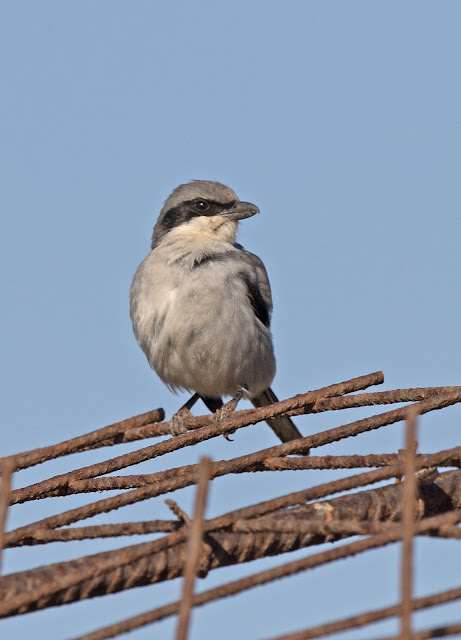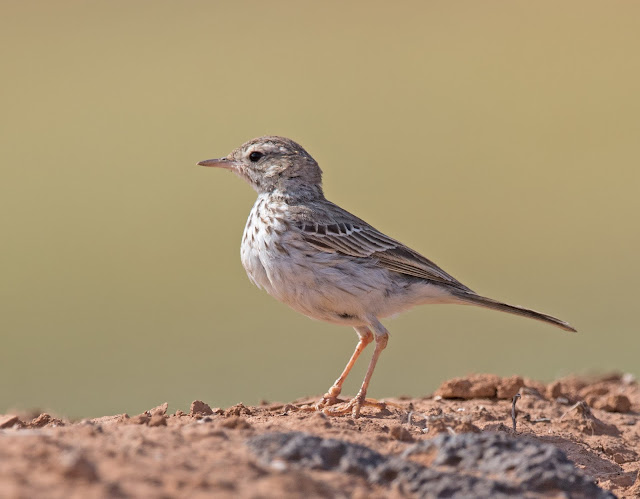First the plugs, if you are going birding in Fuerteventura there are two things that I heartily recommend. The first is a copy of Dave Gosney's "Finding Birds in the Canaries", with its accompanying DVD it is without doubt the best value birding investment that I have ever made. It is worth its weight in gold as the information is spot on - don't travel without it!
The second required item is a mobile "hide" - we had a VW Polo (colour optional) courtesy of Avis, ours was diamond white and the birds didn't seem to mind. It a had developed a distinct "lava dust pink" by the end of the week and we didn't use a whole tank of gas.
The "Field Guide to the Birds of Macaronesia" by Eduardo Garcia-del-Rey is also a very handy book to have available.
So, having been delayed out of Gatwick, heavy winds, we arrived at our hotel just as darkness set in, so no birds on the list on the first day, though squawks and calls from the considerable amount of date palms around the hotel gardens gave me encouragement. Next morning I awoke to a full dawn chorus - hundreds of Spanish Sparrows declaring that this was their territory and that they were willing to fight for it. I opened the bedroom door and stared face to face with one male - I swear he said "Welcome to the Canaries". This choir had a full backing group of raucous Collared Doves - not sure that if I could ever determine an African variety though.
 |
| "Good morning" |
The final icing on the cake was a fly by of an Egyptian Vulture, circling over the road, no problems with the ID as the tail is a dead give away. Oddly enough we only saw two of these throughout our visit, both in the air and I was expecting to find some specimens on the ground although we didn't visit a feeding station. Five life ticks before breakfast on day one - surely it couldn't last.
After breakfast we decided that rather than go any distance we would bird locally in the agricultural areas to the south of the town. This valley manages to retain quite a lot of the rain that runs off the mountain and is always verdant and consequently attracts lots of small birds.
First bird was an obliging Kestrel, not surprising as they are very common on the island, there are of course several races but I don't feel qualified to determine which is which so it remains in the log as "Kestrel". Perhaps with the photographs I will make a judgement in the future.
Throughout the island metal fencing is employed either to keep goats in, or out of, agricultural areas, whilst this provides excellent perches for the bird life it isn't the most eye pleasing in photographs but it does make them easier to spot. As we crept along the dusty track we spied a Southern Grey Shrike on the top and he tolerated us until we got close enough for some good shots.
The Spectacled Warblers were a little more flighty , also the Hoopoes were flitting in and out of view constantly. Next up were two Berthelot's Pipits. On this occasion I got out of the car to get a better view and this was the cue for them to walk towards me until they were within my closest focus distance, rather different from birds back home.
Round the corner we came across a perched Corn Bunting that provided close up opportunities, its rasping call could be heard a long way off. It was unusual to find so many Corn Buntings spread out through the whole area, not a bird I was expecting. Barbary Ground Squirrels were popping out of the stone walls but wouldn't pose, just taking a quick look and then making for cover. In a location that came to be known as "Shrike Corner" we found another obliging bird. Finally at the end of the track we found a pair of shrikes and from their behaviour it was obvious there was a nest nearby. Later in the week I explored the area carefully and found three fledged juveniles.
Whilst photographing the SGS I was treated to a fly by of two Trumpeter Finches, so called because of their obvious call, similar to that made by a child's plastic toy trumpet - a bird that I could never tire of seeing and hearing its call - "paaaaahp". However it has a great scientific name too - Bucanetes githagineus!! Shame they didn't pause for a snap.
In true Spanish fashion we quit for lunch and a siesta back at the hotel, well in the end we sat by the pool and watched the frantic coming and going of the sparrows. The pool looked inviting and with a daytime temperature of 24 degrees I thought a dip might be refreshing. However, having dipped a toe in, I decided to give it a miss, I believe the pool had only one taker all week - it takes time for the water to warm up.
In the afternoon we did it over again - back down the same track as I was keen to get some better Hoopoe shots, on the way down the track the squirrels were now happy to pose in the late afternoon sunshine. As always, introduced species are likely to become a pest, but these chaps don't appear to be doing any harm and around Caleta de Fuste the tourists delight in feeding them peanuts, which they take from the hand.
At the end of the track, by a locked gateway, we had a surprise - at least 20 Hoopoes actively feeding but by Sod's Law they stayed the other side of the fence from our parked "hide". One bonus was the arrival of a nice male Trumpeter Finch that posed atop the fence.
As the sun dropped we made our way back to the hotel, in all a great day as we had seen 8 of our target of 22 species and I had amassed 6 life ticks. Liz was amused to see a large pale camel out in the fields with a couple of cows - I just had to take a snap.
For context this shows the green agricultural area to the south and west of La Oliva, in the foreground our hotel, the Casa Vieja and on the right hand side, in the far distance, the Casa de los Coroneles





























No comments:
Post a Comment